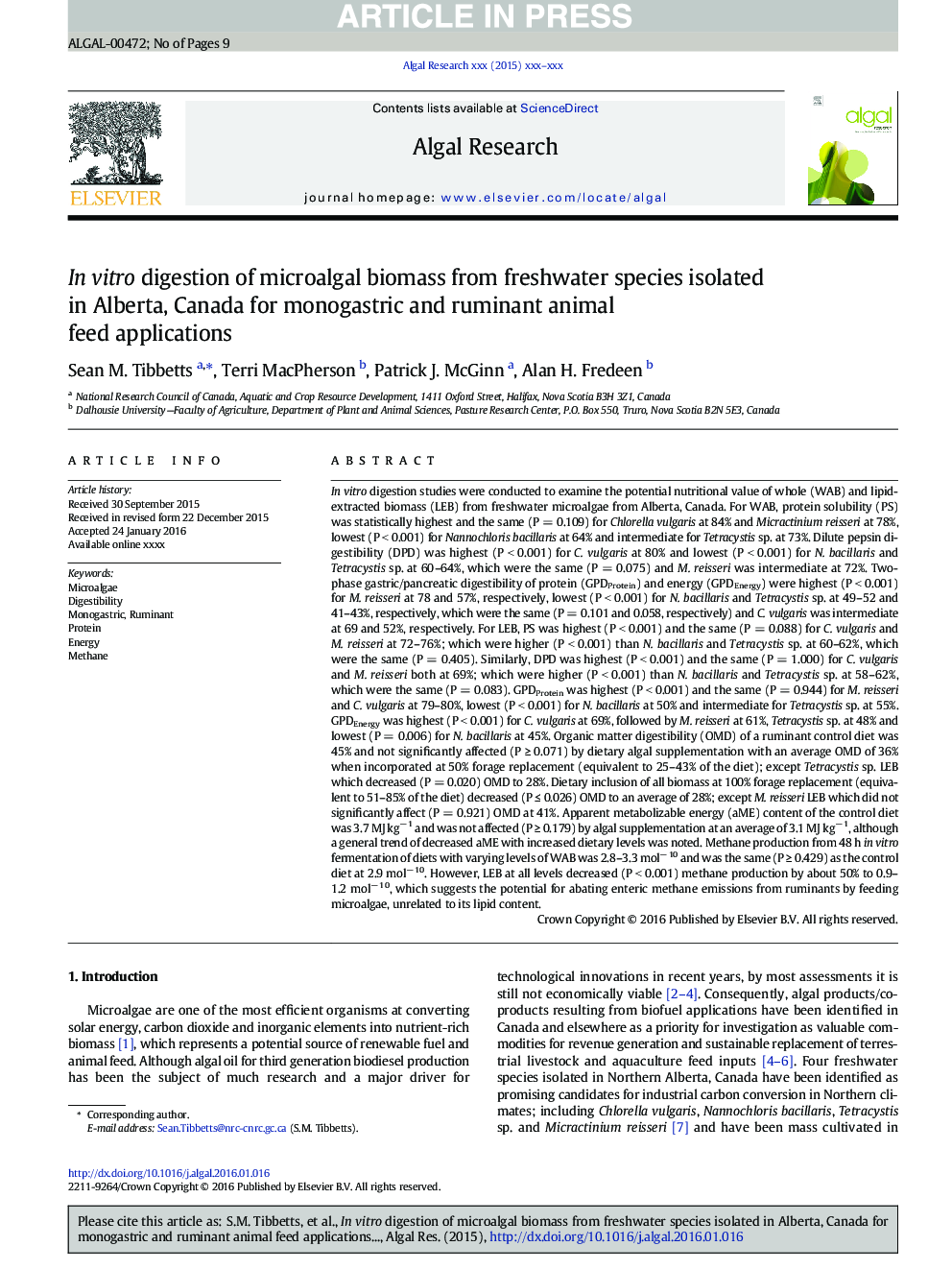| Article ID | Journal | Published Year | Pages | File Type |
|---|---|---|---|---|
| 8086416 | Algal Research | 2016 | 9 Pages |
Abstract
In vitro digestion studies were conducted to examine the potential nutritional value of whole (WAB) and lipid-extracted biomass (LEB) from freshwater microalgae from Alberta, Canada. For WAB, protein solubility (PS) was statistically highest and the same (P = 0.109) for Chlorellavulgaris at 84% and Micractiniumreisseri at 78%, lowest (P < 0.001) for Nannochlorisbacillaris at 64% and intermediate for Tetracystis sp. at 73%. Dilute pepsin digestibility (DPD) was highest (P < 0.001) for C. vulgaris at 80% and lowest (P < 0.001) for N. bacillaris and Tetracystis sp. at 60-64%, which were the same (P = 0.075) and M. reisseri was intermediate at 72%. Two-phase gastric/pancreatic digestibility of protein (GPDProtein) and energy (GPDEnergy) were highest (P < 0.001) for M. reisseri at 78 and 57%, respectively, lowest (P < 0.001) for N. bacillaris and Tetracystis sp. at 49-52 and 41-43%, respectively, which were the same (P = 0.101 and 0.058, respectively) and C. vulgaris was intermediate at 69 and 52%, respectively. For LEB, PS was highest (P < 0.001) and the same (P = 0.088) for C. vulgaris and M. reisseri at 72-76%; which were higher (P < 0.001) than N. bacillaris and Tetracystis sp. at 60-62%, which were the same (P = 0.405). Similarly, DPD was highest (P < 0.001) and the same (P = 1.000) for C. vulgaris and M. reisseri both at 69%; which were higher (P < 0.001) than N. bacillaris and Tetracystis sp. at 58-62%, which were the same (P = 0.083). GPDProtein was highest (P < 0.001) and the same (P = 0.944) for M. reisseri and C. vulgaris at 79-80%, lowest (P < 0.001) for N. bacillaris at 50% and intermediate for Tetracystis sp. at 55%. GPDEnergy was highest (P < 0.001) for C. vulgaris at 69%, followed by M. reisseri at 61%, Tetracystis sp. at 48% and lowest (P = 0.006) for N. bacillaris at 45%. Organic matter digestibility (OMD) of a ruminant control diet was 45% and not significantly affected (P â¥Â 0.071) by dietary algal supplementation with an average OMD of 36% when incorporated at 50% forage replacement (equivalent to 25-43% of the diet); except Tetracystis sp. LEB which decreased (P = 0.020) OMD to 28%. Dietary inclusion of all biomass at 100% forage replacement (equivalent to 51-85% of the diet) decreased (P â¤Â 0.026) OMD to an average of 28%; except M. reisseri LEB which did not significantly affect (P = 0.921) OMD at 41%. Apparent metabolizable energy (aME) content of the control diet was 3.7 MJ kgâ 1 and was not affected (P â¥Â 0.179) by algal supplementation at an average of 3.1 MJ kgâ 1, although a general trend of decreased aME with increased dietary levels was noted. Methane production from 48 h in vitro fermentation of diets with varying levels of WAB was 2.8-3.3 molâ 10 and was the same (P â¥Â 0.429) as the control diet at 2.9 molâ 10. However, LEB at all levels decreased (P < 0.001) methane production by about 50% to 0.9-1.2 molâ 10, which suggests the potential for abating enteric methane emissions from ruminants by feeding microalgae, unrelated to its lipid content.
Related Topics
Physical Sciences and Engineering
Energy
Renewable Energy, Sustainability and the Environment
Authors
Sean M. Tibbetts, Terri MacPherson, Patrick J. McGinn, Alan H. Fredeen,
